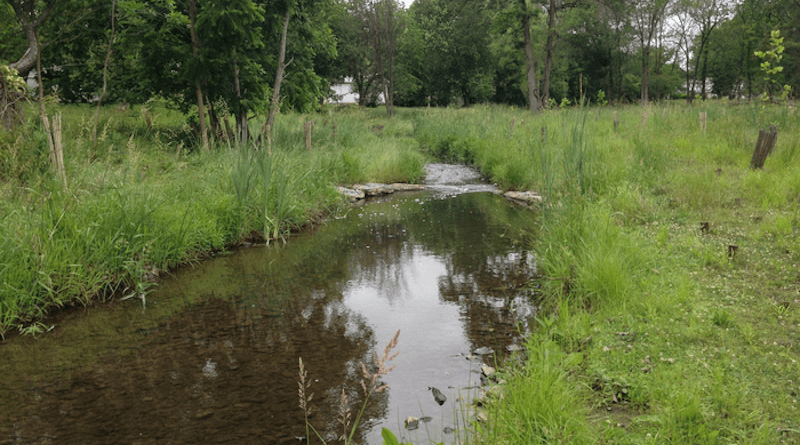Stream Restoration Trade-Offs: Higher Environmental Benefits To Be Had Where Homeowners Are Less Willing To Pay
Although stream restoration filters pollutants out of local waterways and improves the health of the Chesapeake Bay, Baltimore area neighborhoods where it would do the most for water quality are far less willing to pay for such projects, according to a new study by a University of Maryland environmental economist and an interdisciplinary team of colleagues.
The team found that homeowners in the least densely populated, and generally wealthier areas of their study region, were less willing to pay to restore streams, while those in the most densely populated areas, which tended to have lower incomes, were more willing to pay for restoration projects.
The study, which appeared in the journal Environmental Research Letters, should help inform decision makers charged with improving water quality, who often must balance community support with environmental impacts.
“We see this strong urban-to-rural gradient where in urban areas there’s a higher economic potential as far as community support to pay for stream restoration, but less ecological potential to reduce nutrient pollution, and vice versa,” said David Newburn, an associate professor in the Department of Agricultural and Resource Economics at UMD and co-author of the study. “The overall trend is that there’s often a trade-off for environmental and economic benefits from stream restoration projects, and it’s hard to find the win-win locations.”
Stream restoration projects vary greatly with the local environment, but they are all designed to improve the ability of a stream to absorb and process nutrient pollutants and prevent them from flowing downstream. Such projects are central to improving water quality in the Chesapeake Bay and other watersheds around the world. But stream restoration can change the local landscape, sometimes removing trees or adding grassy meadows along streambanks.
Newburn and his colleagues wanted to understand the complex relationship between the environmental benefits of stream restoration and the perceived value to homeowners who frequently pay for them through taxes and fees. The team combined their analysis of one of the most comprehensive data sets on urban stream water quality in the world with a homeowner survey to estimate willingness to pay for various types of restoration projects.
The researchers leveraged long-term sampling data from the Baltimore Ecosystem Study, which has been measuring streamflow and nutrient load (a measure of ecological health of a waterway) since 1998 across fully forested, agricultural and highly developed watersheds. Using modern ecosystem modeling techniques, they estimated how much of the nitrogen would be removed by different stream restoration designs in a variety of settings.
They focused on small, headwater streams within the Baltimore region spanning urban, suburban and exurban neighborhoods, meaning neighborhoods outside of city septic systems that are dominated by single family homes on one to five acre lots. Newburn and his colleagues developed hydrologic models that showed stream restoration had the most nitrogen reduction in the less densely populated exurban areas, where small streams predominantly have low flows. Streams lined by grassy buffers had the highest nutrient reduction compared to tree-lined streams.
The researchers suggest that low water flow in these areas allowed the streams to process nutrients in the water, and grassy buffers allowed more sunlight to reach the water than did tree covered stream banks. Sunlight is important because it helps the algae in streams to remove nitrogen from the water more effectively.
The projects that had the least nitrogen pollution reduction were in the most densely populated, urban areas of Baltimore city. In these neighborhoods, urban runoff from impervious surfaces like rooftops and parking lots leads to local flooding during rainstorms, and the torrents of swift-moving water do not allow streams time to remove a substantial portion of the nutrient pollution.
Next, the researchers used homeowner survey data to analyze willingness to pay for different stream restoration designs and mapped their results throughout the study region.
“In rural areas you get this high environmental benefit, that has high potential to remove nitrogen pollution from waterways, particularly when you remove trees and have grassy streambanks to open up the streams to sunlight,” Newburn said. “But that’s where you get the lowest willingness to pay and sometimes even resistance to tree removal from nearby homeowners compared to doing restoration somewhere else.”
Trees often represent an amenity that has value because homeowners enjoy their aesthetic benefits, and removing them equates to removing this value from the neighborhood. But in densely populated urban areas, where streams were more likely to be surrounded by man-made infrastructure, the addition of grassy meadows or trees during restoration provides green-space amenities that are often lacking, particularly in lower-income urban neighborhoods.
Newburn noted that the added green space in urban areas has social benefits beyond water quality improvement that may be factored into the environmental and socio-economic analysis for decision makers. He also suggested that in the future, research on additional benefits of restoration projects such as reducing urban heat islands, restoring habitats, and quality of life benefits may reveal a greater balance that favors some projects more clearly than others.

